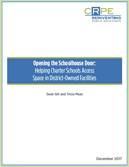Charter schools are an important part of a city’s improvement strategies, yet the growth of high-quality charters is often constrained. When promising charter schools don’t have access to buildings and district-owned buildings sit idle or are underenrolled, the array of public school options for families becomes limited.
To explore the effect of district-charter cooperation on facilities access for public charter schools in a range of political circumstances and state policy frameworks, CRPE researchers spoke with facility and charter school experts, reviewed laws in all 44 states with charter schools and the District of Columbia, and conducted site-specific interviews with district and charter leaders.
How sharing facilities can benefit districts
Districts can better serve families when they view charter schools as playing an important role in citywide improvement. Renting or selling space to charter schools can be a source of revenue or a way to reduce costs, and charter schools can provide new options to families and develop solutions to share with other public schools. Another option is to create third-party trusts to manage all public school buildings.
How state policymakers, school district and charter leaders, and philanthropic and support groups can encourage good use of district facilities
To make headway in opening up facilities for high-quality charter schools, state policymakers should try a variety of options, such as giving incentives to districts to provide space for charter schools, giving incentives to district and charter schools to work collaboratively on master facilities planning, strengthening state oversight of districts’ facilitiesplanning, piloting third-party facilities management, and more.
School district and charter school leaders should create processes that fairly allocate facilities space between district and charter schools, develop standard leases or a schedule of costs that charter schools will pay to the district, and investigate areas where district and charter schools are already collaborating to determine if a facilities access solution is possible.
Philanthropic and support groups should establish third-party brokers or trusts that take a citywide approach to education facilities.





